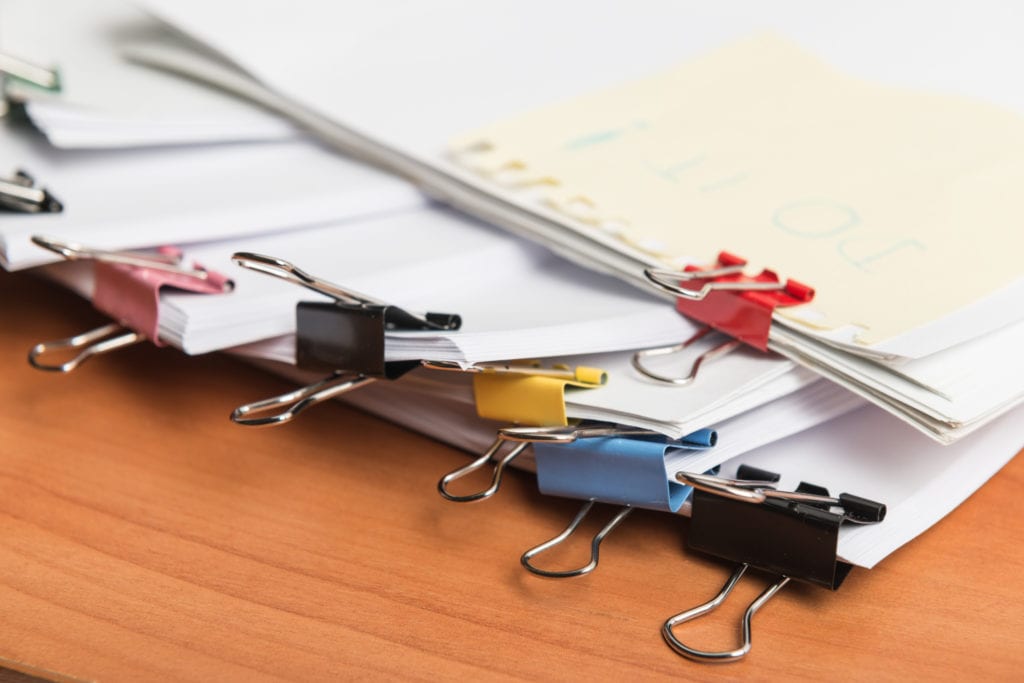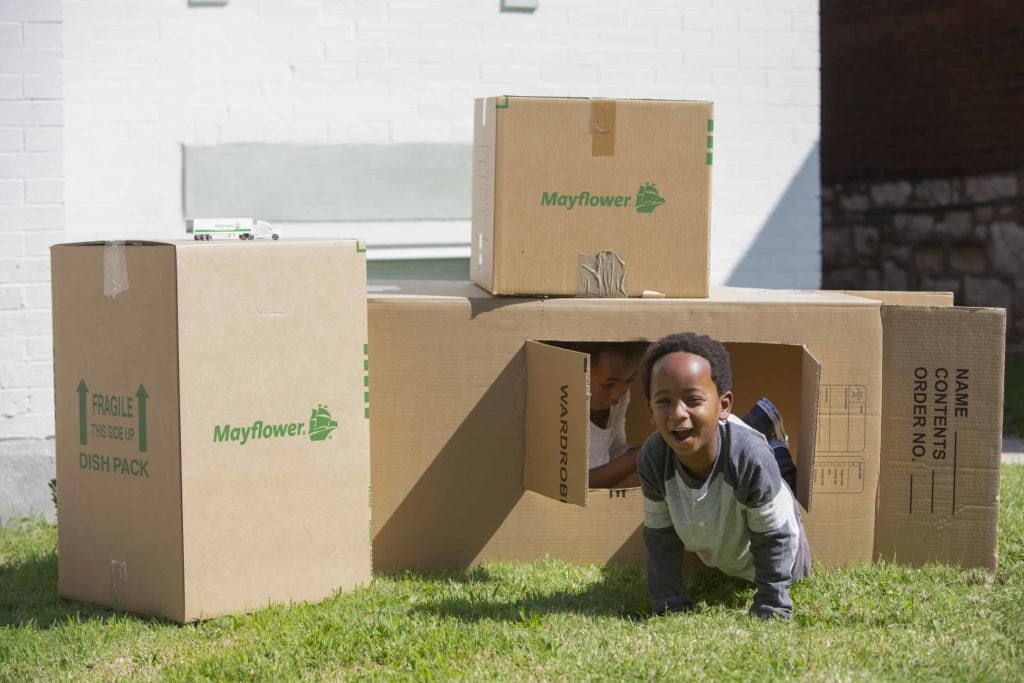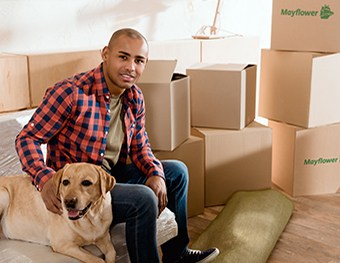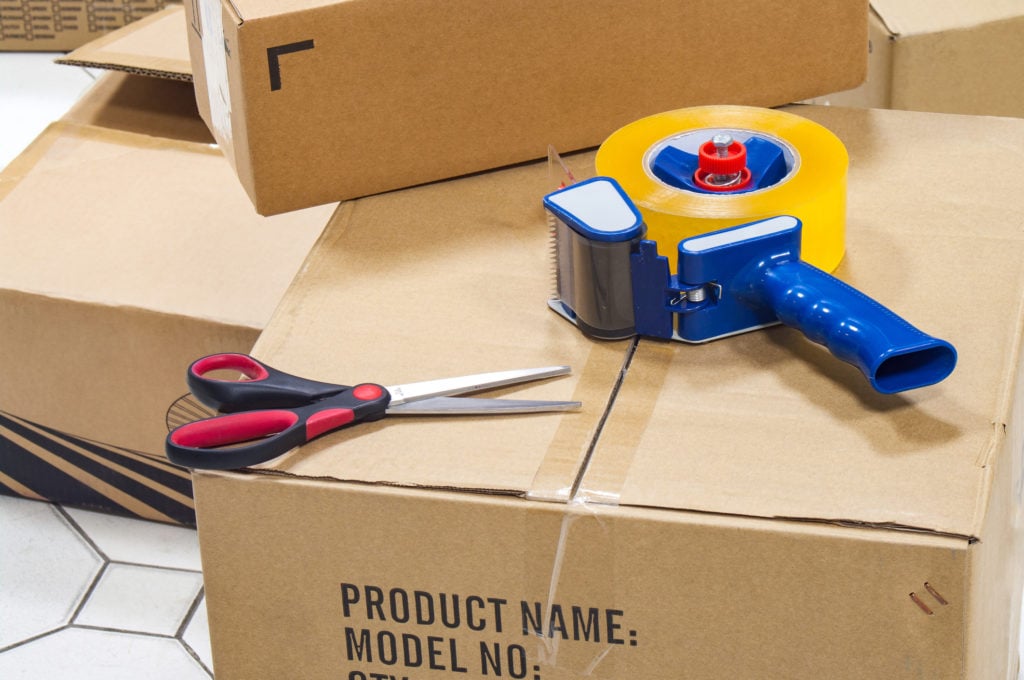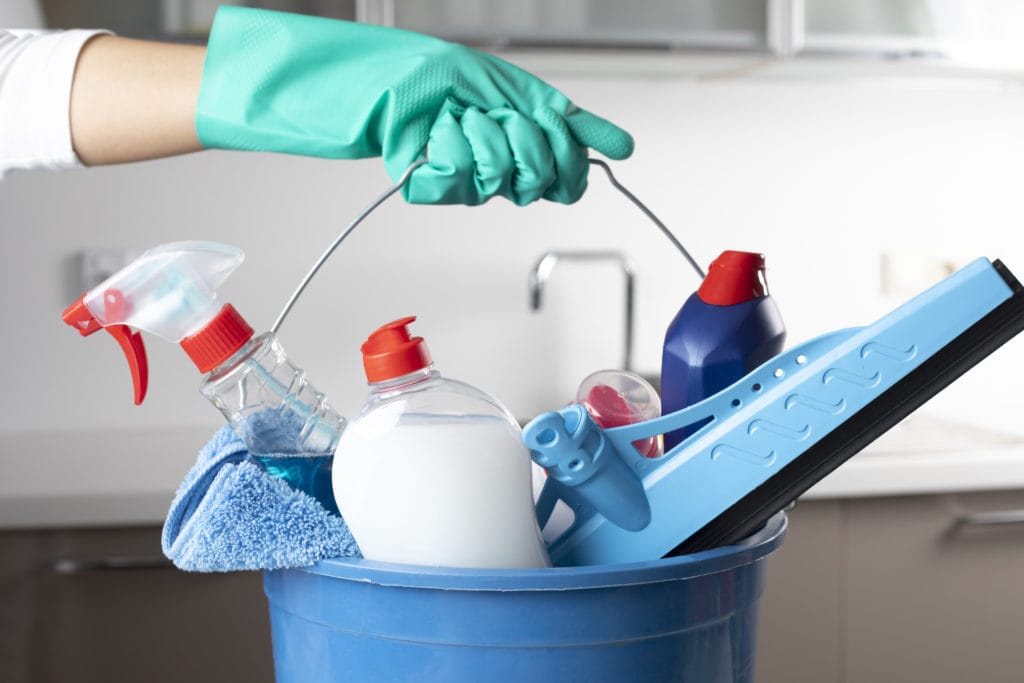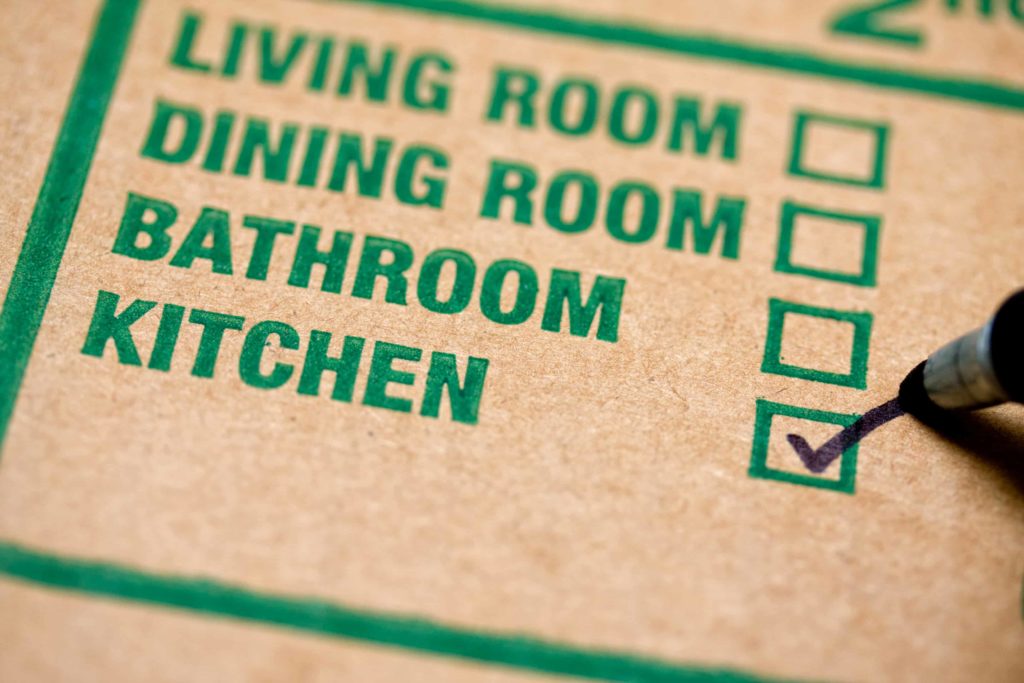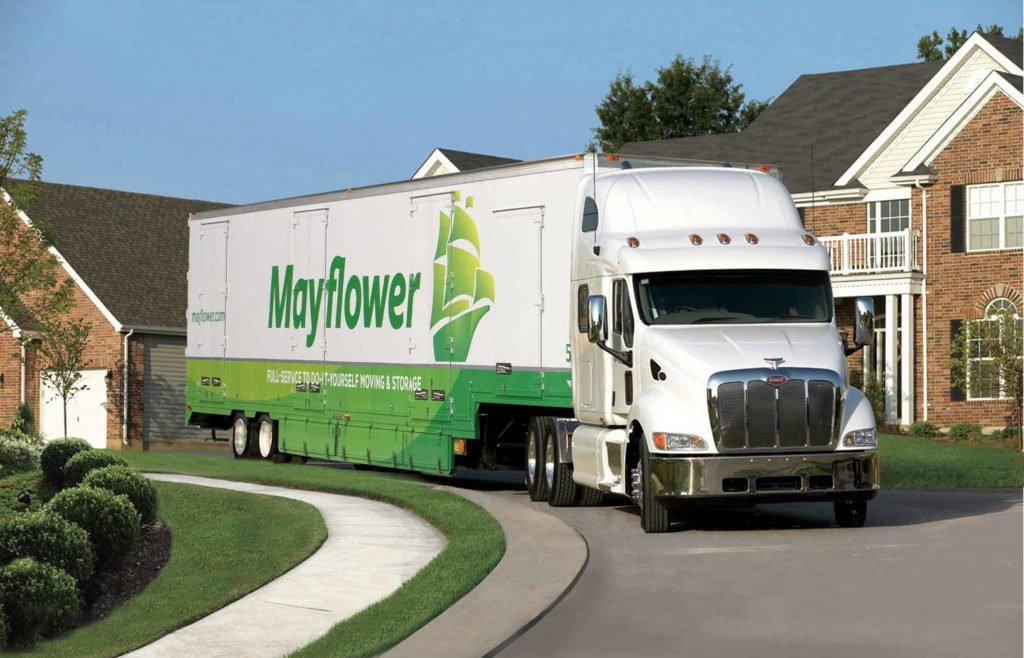Make your move easy by using the moving checklists, planners and tools developed by the trusted movers at Mayflower. We created this comprehensive checklist based on our 90+ years of experience moving customers all across the United States! Whether you are ready to move or just beginning the process, our 8-week moving planner includes the tips you need to plan a seamless transition.
The Ultimate Moving Planner
Mayflower makes planning your move easy with help from the only moving checklist you’ll ever need. When you move with Mayflower you have access to MyMayflower, the ultimate moving planner tool. MyMayflower lets you plan your move and easily check off items as they are completed.
Get Started
8 Weeks Before Your Move
You’ve decided it’s time to make a move. Congratulations! This is an exciting time of your life. Mayflower’s trusted movers recommend that you start checking things off your to-do list eight weeks in advance. Beginning your moving planner at eight weeks allows you to spread out the responsibility into manageable steps and reduces the chances that you will feel overwhelmed or miss critical items on your checklist. At eight weeks out from the move, the first steps help prepare for the overall moving process.
Search for Your New Home
There are many reasons to look for a new home both locally and across the country. Whether your reasons include school, work, family, or even just a desire for a new adventure, the process of finding your dream home is the same:
- Use online real estate apps and websites to perform your initial home or rental search.
- Research local realtors in your new area or, if you have used a national real estate company in the past, request a referral.
- If you’re moving with Mayflower, check out our CityPointe program. You can earn cash back on the sale of your home!
- Map out what you’re looking for in a new neighborhood, including school districts, work commutes, crime statistics, nearby businesses (restaurants, gym, gas stations, etc.), nearby medical services and nearby pet amenities.
- Map out what you’re looking for in a new home, including size, floors, closet space, recent remodeling, age of home, number of rooms and bathrooms and other desired features.
Sell Your Home
For many movers, it is necessary to sell a current home before making a move. Selling a current home before purchasing a new home may be financially beneficial as the equity from your current home can translate into a down payment for your new home. When planning a move, it is important to allow time for viewing, negotiation, and inspections that are necessary before closing. Starting this process fewer than eight weeks before a move can result in the need to balance overlapping mortgage payments on top of the costs of moving.
- Work with a realtor to prepare your home for sale, including listing your home, scheduling inspections and your closing date.
- Either DIY or use a contractor to help you stage your home.
- Have all of your dates in alignment with your move timeline.
Plan Your Sale
Prepare to Transition to a New Lease
If you are renting your current residence, the process initially looks different compared to that of homeowners. Renters should review their current leases immediately before planning a move to ensure that all conditions of the lease are met, and proper notice has been given. Waiting too late to notify a landlord or management company can result in additional fees that add costs to the bottom line of your move.
- Provide proper notice to your landlord according to your lease.
- Request your security deposit be returned, if applicable, on a specific date.
- If you need to find a roommate at your new location, it may be best to start searching early.
Get Organized
As you progress through your moving checklist, you are ready to begin the process of searching for quotes, updating paperwork and managing the moving process. This involves a lot of paperwork and it is important to start with an organized approach to recording costs and paperwork related to your move. Use Mayflower’s organization checklist to ensure that you have a plan for managing all of the paperwork throughout the process.
- Create a move folder for all of your moving-related documentation, research, estimates, receipts, important signed documents and notes. You can keep a physical file, an electronic file in the cloud or both!
- Designate a moving folder in your email inbox to keep correspondence relating to your move organized and easily accessible.
- Create a detailed budget for your move. Before you begin researching companies and quotes, determine how much you want to allocate for your move. Then, estimate the costs and expenses that fit within your budget.
- Create a move calendar to help you notate all of your important dates, including your move-out date, move-in date, packing schedule, closing date, lease termination date, travel dates and other deadlines.
Gather Quotes and Pricing Information
Once you have determined that you would like to move, it is important to know how much a move will realistically cost. As you begin the process of budgeting your move you should seek pricing and quotes from reliable moving companies. You will be asked basic questions during this process such as where you will be moving, what types of items need to move and do you require packing assistance. The more you are able to share, the more accurate your initial moving estimates will be.
- Protect yourself from moving scams. Understand what red flags to look for and how to spot a fraudulent moving company. Visit MoveRescue®, a Mayflower-endorsed organization, to learn more.
- Determine which moving services you need. Full service moving companies, like Mayflower, offer a wide array of services that customers can choose from to meet their needs, budget and timeline, including packing, unpacking, storage, debris pick up, car shipping, tv mounting, and more.
- Be prepared to answer basic questions about your move, including your move dates, origin/destination zip codes, home size, how many floors your home has, which additional moving services you need and if you have any specialty items.
- Understand the factors that can affect the amount of your moving quote, such as seasonality, additional services, distance, weight, etc.
- Understand the difference between an instant quote, a ballpark estimate and an estimate that you would receive after a virtual or in-person walk-through.
- Research companies that you are considering online. Check out their websites, reviews and social media accounts, as well as their listings on local business directories.
- If yours is an interstate move, ensure that the companies you are looking at have a DOT number which federally authorizes them to transport your belongings across state lines.
- Schedule a virtual or in-person walk-through, if applicable. Make sure to ask your estimator any questions you have about costs, services, delivery timing and the moving process.
- Understand your moving company’s responsibilities vs. your responsibilities.
- Understand what’s included in your base price.
- Understand your move protection options and claims process. Interstate moving companies are required to offer Full Value Protection for moves that involve transporting goods across state lines.
- Compare your estimates and decide which moving company gives you the most value for your dollar while meeting all of your needs, then book your move!
Get A Moving Quote
Moving With Mayflower? Schedule a Walkthrough
The first step in our process is scheduling a virtual or in-home walkthrough to provide an estimate for your move. This allows us to give the most accurate estimate of your move and kicks off the process of planning a move with a trusted mover.
- If you are interested in obtaining a moving quote from Mayflower, call 877-720-4066 or complete the form online to schedule your virtual or in-home walk-through.
- A virtual walk-through allows customers to walk an estimator through their home using our Virtual Survey app on their mobile device. (We will send you all of the details about the app once you schedule your walk-through.)
- An in-home walk-through is an in-person visit by an estimator at your home.
- During your walk-through, your estimator will take a visual survey of your home and all of the belongings that you would like to move. Being able to see your home layout and all of the items that we will be handling for you helps us to provide a more complete moving quote.
- Your estimator will help you determine which services you will need to make your move easier, whether you need help packing, storing items or moving your car.
- Once your walk-through is complete, your estimator will provide you with a written estimate for your personalized move plan.
- Is your company paying for your move? If so, refer to your company’s policy to ensure you are clear on which services your moving company will be authorized to perform.
Request A Walkthrough
Back To Top
7 Weeks Before You Move
With the initial budgeting and home estimates out of the way, seven weeks prior to your planned move is an important time to address the personal components of your moving checklist. Mayflower’s moving planner includes steps to help manage the transition with family, friends & pets this week.
Prepare Your Family for Your Move
While parents are involved in the moving process from start to finish, it is important to prepare children for the weeks ahead. Your family may need to be involved with keeping the house clean for showings, planning for a new school or saying goodbye to friends and neighbors. It is important to handle this process with care and understanding to make the transition as smooth as possible.
- Talking to your kids about your move can be hard, especially if they have built friendships at your current location. Try to sit down with them early and often to help them prepare for the transition.
- If possible, set up a time to visit your new home and area with your family to acclimate them to the new location.
- Discuss positive aspects of the change such as new activities that may be available.
Tips To Prepare Your Family
Pets are Family Too
Pets are an important part of the family and require special consideration when moving. You will have to consider the availability of dog-friendly locations, whether you will have access to a private yard or dog park and more when making the choice to move with your furry friend. Be sure to consider the items on your moving checklist that relate to your four-legged friend before committing to a move.
- If you’re moving with pets, research pet-friendly / dog-friendly parks and restaurants nearby.
- Look into veterinarians in your new local area and check out their reviews.
- Research doggie daycares and dog walking services in your new area and check out their reviews.
- Take your pets to the veterinarian for a final check up before travelling.
Tips For Moving With Pets
Notify Your Children’s School
If you have kids in school, addresses will need to be updated. If your move takes you to a new district, a new school will need to be identified and transcripts transferred. This is important, because understanding the school district can have a significant impact on your child’s education and happiness in their new school. Once you have decided on a new school, you can address the following items in our checklist.
- Notify current school about your upcoming move.
- Research schools for your kids in your new city with a list of requirements and preferences.
- Complete any required school registration documentation.
- Schedule an in-person visit at the new school.
- Transfer transcripts, medical records and any other required documentation to the new school.
Tips For Moving With Kids
Notify Your Employer
If you are planning to retain your current job after your move, there are several items you should share with your employer to make the transition as smooth as possible. If you are looking for a new job prior to the move, you should be several weeks along at this point to ensure that you do not face a gap in employment after your transition.
- Plan your new commute to work.
- If you are working from home, consider how to make the transition to a new home office the easiest for you and your employer.
- Research nearby businesses, such as restaurants, gas stations, drug stores, etc. you might frequent during the work day.
- Make sure you understand your employer’s parking policies and procedures.
- Make sure you understand your employer’s safety policies and procedures in light of the pandemic.
- Research dry cleaners in your new area in case you need to refresh your work clothes.
- Confirm your work start date and time.
- If needed, request time off work for move preparation, move-out day and move-in day.
- Make sure that your payroll department has your new address for mailing tax paperwork and your final paycheck if you are leaving your current position.
- If you are seeking employment, begin your job search as soon as possible with an updated resume, cover letter and portfolio. Reach out to recruiters in your new local area.
Planning A Job-Related Move
Book Your Move
If you are moving with a trusted Mayflower mover, it’s time to sign your estimate and book your move. This will allow you plenty of time to secure your date. You will be connected with a move coordinator who will assist you at every step of your moving plan.
- When you receive your official estimate, make sure that you have a clear understanding of each section.
- Read the “Your Rights and Responsibilities” document which will be provided by Mayflower prior to your move. This document is required by law and outlines all of the things you need to know.
- Once you lock in your move-out date and confirm your plan, you will book your move.
- If you have any questions about your estimate, rights and responsibilities or booking your move, reach out to your move coordinator who will be there to help you every step of the way.
- After your move is booked, you’ll be given a unique link to MyMayflower which is an online portal. This portal will contain everything pertaining to your move, including your move coordinator’s contact information.
Hire A Moving Company
Back To Top
6 Weeks Before Your Move
Week six is the time to prepare and protect important documents, files, and other information that will be important to keep safe in your move. During week six you should also begin to update documentation with important institutions and share your change of address with others.
Protect Important Documents
When moving homes, it is important to locate and protect sensitive documents by creating copies where possible and securing originals. Documents are one item that you should plan to move yourself in order to account for their safety and security at all times.
- If you have physical documents, consider scanning them to the cloud.
- Make sure to secure your logins and passwords for online accounts in a safe place. You may want to use a physical file, cloud storage or a password service.
- Secure documents like, passports, birth certificates, social security cards and financial statements in a secure place. You should bring these items with you and not put them on the moving van.
- Ask your mover how they would handle moving a safe or bring it with you during your move.
- Collect all product warranty documentation and manuals in one place.
- If you have files saved on your local computer drive, you may want to back those up to the cloud.
Protect Personal Items
Back To Top
5 Weeks Before Your Move
With only five weeks to go before the big day, your moving checklist is getting shorter and shorter. Now that you’ve thought about the physical documents you need to keep safe in the move, it’s time to start focusing on the documents that you don’t physically keep in your home.
Transfer Important Documents
A new location often means that businesses and medical providers that you frequented are no longer accessible. If you have identified providers in your new location, you can begin the process of requesting that records are transferred. This will make it easier for you when you visit these offices for the first time as a new patient.
- Plan to transfer any medical records from primary care physicians and specialists to new service providers, including vaccination records. Some service providers offer online medical record portals that you can use to upload documentation.
- Plan to transfer any dental and optical records to new service providers.
- Plan to transfer any prescriptions to your new pharmacy.
- Plan to transfer any pet medical records, including vaccination records, to your new veterinarian’s office.
Back To Top
4 Weeks Before Your Move
Start Decluttering
Decluttering is a hidden benefit of moving. No doubt you have a basement storage unit or attic that you have been meaning to clean out. Decluttering before you move offers the dual benefits of reducing your moving costs as well as allowing you to start fresh in your new home. Decluttering is one of our favorite items to check off of our moving planner checklist.
- Start by going through one room at a time to sort through what will move with you and what will not.
- Have extra stuff? Organize a garage sale or online sale to get rid of anything you won’t be taking with you.
- Donate any unwanted clothing, furniture or other household goods (pots, pans, dishes, bedding, etc.) to your favorite charities in town. Don’t forget to grab receipts showing the items’ approximate value for possible tax deductions.
- Buy only the food you will need up until move day. Clean out your cupboards and donate or remove any perishable items you will not need prior to the big day.
- Start to use up items like household cleaners, rolls of paper towels, etc.
- Toss or recycle anything that can’t be donated, sold or gifted. Keep in mind there might be a limit as to what you can put at the curb each week.
- Be sure to check the non-allowables list for items not allowed in your shipment. If you are unsure of how to properly dispose of these items, Mayflower recommends visiting earth911.com to help you find appropriate recycling centers in your neighborhood.
Decluttering Tips
Begin The Packing Process
When looking around your current home, packing can seem overwhelming at first. Starting the process early can help spread out the work and keep things manageable during the move. Mayflower’s packing tips can help you streamline the process and pack as efficiently as possible. Remember, it will all be worth it when you are comfortable in your new home.
When looking around your current home, packing can seem overwhelming at first. Starting the process early can help spread out the work and keep things manageable during the move. Mayflower’s packing tips can help you streamline the process and pack as efficiently as possible. Remember, it will all be worth it when you are comfortable in your new home.
- Designate at least one week to pack.
- Designate an area of each room, that’s out of the way, for packing ahead.
- Familiarize yourself with the different types of boxes and packing materials you might need.
- Gather your basic packing supplies, like scissors, tape, markers, baggies, padding and hardware/tools.
- Utilize our moving tips for packing specific items and rooms. Items in different rooms will likely require different packing materials. For example, you might need a dish pack for packing kitchen dishes or a wardrobe box for packing hanging clothes in your bedroom.
- Pack items in each room that you know you will not need immediately (for example, seasonal items such as winter or summer clothes, holiday decorations, special dishware/china, decor items (like candles or picture frames), etc.).
- Make sure you understand what items are hazardous and/or not allowed on the moving truck.
- Consider items you’ll need for the first night in your new home and pack those items together, including things like shower curtains, bedding, clothes, snacks, laundry detergent, dish detergent and toiletries. See our Pack Separately Checklist here for additional tips.
- Make sure you understand how to pack items like lamps, vacuums and small appliances, like microwaves, blenders, TVs and computers.
- Create an inventory of your belongings. You may want to take photos of your items for your inventory as well.
- Label your boxes by room on the side of the box. Make sure to note if the contents inside are fragile or heavy.
- Use linens and t-shirts to pad boxes as you pack to keep your items securely in place.
- Make sure to keep furniture hardware separate, so you can find when it’s time to reassemble.
- Ask your mover if they will transport plants. If not, you can either move them in your vehicle, donate them or dispose of them.
Download Our Packing Checklist for Moving
Check In With Your Move Coordinator
As you get closer to your moving date, it is common for your needs to change. Checking in with your move coordinator will ensure that you remain aligned on the date of the move. If you have added a stop at a storage unit or purchased additional furniture this will need to be factored into the cost of the move. Reconnecting with your coordinator can help eliminate surprises on moving day.
- Was your garage sale a big success? Donate more than you planned? Notify your Mayflower move coordinator if you add or subtract items from your planned move or if there are any changes in dates.
- Be sure your move coordinator has the destination address and phone numbers where you can be reached.
- Confirm any extra stops required to pick up or deliver goods to a location other than the main pickup or delivery points.
- If your car is being moved, be prepared to drive it to the loading site for auto transport. Also, be prepared to pick up your car at your destination location; again, your move coordinator is here to help. Do not be afraid to reach out if you have questions.
Moving With Mayflower
Back To Top
3 Weeks Before Your Move
You are more than half-way to your moving day! Now is the time to start tying up some loose ends at your current residence. The next two weeks can feel hectic, so Mayflower recommends designating week three of your moving planner to focus on paperwork.
Update Your Address
Now that your final destination has been confirmed, it is time to update your address. Completing paperwork now will save you the hassle of redirecting mail and reduce the risk that you will miss an important bill or communication. Use our helpful change of address checklist to simplify the process.
- Update your address for your financial accounts: bank accounts (checking, savings), credit card accounts, investment accounts and loan accounts.
- Update your address for subscriptions: online shopping, streaming services, food delivery, other monthly service and product subscriptions (beauty, clothes, food, etc.).
- Update your address for your insurance policies: health, vision, dental, renter’s, homeowner’s, car, pet and life.
- Update your address with your lawyer.
- Update your address for any newspaper or magazine subscriptions you have.
- Update your address on your W-2s, 1099s and property taxes.
- Update your address for any medical bills you may have.
- Update your address with the Social Security, Veterans Affairs, Internal Revenue Service, Medicaid and Medicare offices, if applicable.
- Update your address with your employer and payroll department.
- Update your local voter’s registration office that you are moving.
Cancel Your Local Memberships
Leaving your current neighborhood can also mean leaving your current gym or community center. Checking your memberships to determine if they can be transferred can help you save money and avoid cancellation fees.
- Provide notice and cancel local memberships, like fitness organizations (gym, yoga), business associations, social clubs, etc.
- Search online for gyms and similar businesses close to your new location and schedule tours where needed to get a feel for the facilities.
Plan Your Goodbyes
Moving can be bittersweet. It is important to keep family and friends involved and updated. While your immediate family members may be apprised of your plans, you should also notify extended family members and friends. Many friends and relatives will want to say goodbye in person, so scheduling early can help you avoid having to turn down invitations and plans closer to your moving day.
- Gather with neighbors, friends and family before your move.
- Schedule time to visit some of your favorite places, such as restaurants, museums and parks before your departure.
Back To Top
2 Weeks Before Your Move
Two weeks out is the perfect time to start cleaning your home, packing things up and making sure everything is in place for your move. At this point, you will be close enough to moving day to have non-essential items in boxes including out of season clothing or decorations.
Prepare Your Home
Whether you are moving from a home or a rental, there are several tasks that must be completed in your current home to prepare for your move. Mayflower’s home preparation plan is designed to be an inclusive moving checklist that can be used regardless of your current situation:
- Clean your home. Many people use move-out cleaning services. If you choose to clean yourself, make sure to mop, dust and wipe down surfaces, blinds and baseboards.
- Remove nails and screws from walls and fill in holes with spackling.
- Prepare furniture with padding and floor protection. Make sure to keep furniture hardware and foot sliders separate for easy access at move-in.
- Make any necessary repairs for return of security deposit.
Plan For Move Out
Prepare for Your Trip
If you are planning a long-distance move, you will need to prepare for the travel between your current home and your final destination. You will need to have a moving plan in place that will vary depending on your mode of transportation. Consider all of the items below:
- Compile a playlist with some favorite songs and soundtracks.
- Plan your route, hotels, places to stop to eat, gas fill-ups and attractions.
- Prepare clothes, toiletries, snacks, electronics and other items you might need for your travels to your new home.
- Pack activities, coloring books, tablets, books, markers/crayons and favorite toys for kids.
- Be aware of the weather for the week of your trip.
- Keep in mind things you need to have on your person during your move. Many people choose to keep things like important personal documents, photographs and portable valuables, like electronics and jewelry, separate from items to be loaded onto a moving truck.
- Service your vehicle/s if you are driving to your destination, including oil change/s. Make sure you fill your gas tank as well.
- Make your travel arrangements if you’re not driving.
- Connect with your move company to confirm details if you are shipping your car to your new destination.
Plan Your Cross-Country Move
Take Care of Last-Minute Items
You can avoid many last-minute errands by planning ahead with your handy moving checklist. Run through your list several times and ask other members of your household to provide the items on their errand list to streamline the process.
- Return any borrowed items to friends, neighbors, co-workers, family, etc.
- Return books back to the library.
- Take any items that need to be returned to local stores.
- Pick up any remaining clothing items from the dry cleaner.
- Make sure to pay any fees or penalties, like unpaid parking tickets, legal fees and local or state tax payments.
Double Check This List!
You may have had to skip items on your moving checklist throughout the process. Now is your chance to review all of the items that you may have missed to ensure a smooth moving day. It’s also a great time to check in with your move coordinator to realign on your moving plan and any elements that may have changed.
- Make sure you have not forgotten any of the critical items.
- Have you packed or gotten rid of everything that’s not moving?
- Have you confirmed all the details with your move coordinator?
Back To Top
1 Week Before Your Move
A moving plan is critical during the final week before your move. This is the time to handle any remaining planning and prep work, and a final sweep should be conducted to make sure everything is in place. At this point, the trusted movers at Mayflower recommend that you do not skip items on your moving checklist as it may complicate your moving day and slow the process considerably if all preparation has not been completed in advance.
Prepare Your Appliances
Whether you are moving your appliances or leaving them for new residents you will need to consider how you should prepare. Several appliances will require downtime before they can be moved, so it is important to review your moving checklist one week prior to the arrival of your movers and make a plan.
- Unplug, empty out, defrost, wipe down and open the doors of your freezer, ice maker and refrigerator at least 24 hours before your movers are set to arrive.
- Disassemble your water filtration system.
- Empty dishwasher and let it air out, so there is no moisture inside.
- Disconnect and disassemble/stabilize your washer and dryer.
- Make sure that there is no oil or gas inside any grills, lawn mowers and/or other gas-powered items.
- Remove/return any propane canisters.
- Disassemble garden hoses and lawn care equipment and allow sufficient time for them to dry out.
- Pack up any smaller appliances, like your microwave, air fryer, crock pots and pressure cookers. Make sure to pad boxes with material to avoid damage.
- Remove light bulbs from lamps and lighting fixtures and pack those securely with lots of padding to avoid breakage.
- Disassemble televisions and mounting systems.
- Disassemble computers, printers and scanners.
Pack And Move Appliances
Set Up Services at New Home
Now that you have prepared your appliances and addressed utilities at your current home, you can set up service in your new location.
- Make sure to schedule appointments with your new utility/home service providers ahead of time, including gas, electric, trash, water, recycling, cable and internet.
- Prepare a list of contractors (plumbers, HVAC, painters, roofers, remodelers, electricians, landscapers, etc.) that you’ll need. Do some research ahead of time and keep this list on hand for move-in.
Plan for Moving Day
Planning for moving day is a critical factor in the success and simplicity of your move. Whether you are working with a professional moving company or handling the details on your own, there are many last-minute items to consider.
- Arrange daycare for kids / pets for move-out day.
- Meal prep for the week leading up to move-out day.
- Identify any extra-fragile items needing special attention. If certain items should not be packed or moved, mark them appropriately.
- Label any items or boxes you will want first when the truck arrives at your new home (valuables, electronics, etc.).
- If you are doing your own packing, make sure everything is ready to go before moving day. Upon arrival, the van operator will check to see if boxes have been properly packed.
- If Mayflower is helping you pack, collect things you definitely want packed together, such as children’s toys and place in separate groups.
- Unplug all electronic appliances 24 hours in advance of a move, except plasma televisions, so that they will be at room temperature on moving day. This includes home computers, stereos and audio/video equipment.
- Review your first night box and ensure all items are accounted for.
- If you would like to tip your movers at move-out and move-in, know that tipping is optional and the tip amount is at your discretion.
First Night Box Checklist
You’ve Checked Your Boxes – And It’s Moving Day
Moving day has finally arrived. You have planned and prepared for your move to the best of your ability. Your remaining job is to execute the moving plan with the help of trusted movers. Keep your moving checklist handy throughout the day as you complete the process to ensure that you are involved in big decisions and make the transition as smooth as possible.
Moving out Plan
Having a plan for move-out day will streamline the process and ensure that you make the best use of all of your resources when they are available. You should have a timeline handy and a checklist of important items for anyone who will be assisting with your move including movers, friends, family or other members of your household
- Check in with your mover and confirm arrival timing.
- Prepare a cooler with water and snacks.
- Make it a point to be on hand to see that all of your goods are loaded; remain close by until loading is complete. After making a final tour of the house, check and sign the inventory list. Be sure to get your copy from the van operator and keep it safe.
- Check in with your move coordinator and ask any remaining questions about your moving services.
- There will be some necessary paperwork on the big day:
High-Value Inventory form: complete and sign stating whether or not items of extraordinary value are included in the shipment.
Bill of Lading/Freight Bill: includes the terms and conditions under which your goods are moved and is also your receipt for the shipment.
Extraordinary (Unusual) Value Article Declaration: If applicable, check this box on the Bill of Lading.
- Give the van operator the exact destination address.
- Be sure to let the van operator know how you can best be reached, pending the arrival of your belongings.
- Leave a nice welcome note for the incoming residents.
- Make sure you have all of the items you don’t want moved in a separate area of your home or in your vehicle. Make sure to note these items to your movers.
Move Out Plan
Moving in Plan
Depending on where you are moving, your move out day and move in day may be different. Having a plan for your move-in day will ensure that you have all of the needed supplies and essentials accessible for your first night in your new home.
- Keep an eye on the weather, so you know what to expect.
- Have your first night box ready and accessible on arrival.
- Make sure your floors are protected.
- Measure rooms and doorways for easy furniture placement.
- Set up your shower curtain/s in bathroom/s.
- Assemble and make your bed.
- Assemble and make your kids’ beds.
- Make sure you have food, clothes, water and a backup plan for lodging in the event that the movers are late or cannot deliver on move-in day.
- Baby-proof your new home.
- Consider changing your locks for additional security.
- Make copies of your keys as needed.
Back To Top
Delivery Day
Now that you have arrived in your new home, you are ready to accept delivery of your items from your movers. Use the moving checklist below to make sure your delivery day goes smoothly.
- Be on hand to accept delivery. If you cannot be there personally, be sure to authorize an adult to be your representative to accept delivery and pay the moving charges for you.
- On the day of delivery, the van operator will attempt to contact you by phone and/or will stop by your new home if he/she is unable to reach you. If you or an authorized individual cannot accept delivery of your belongings within the free waiting time (i.e., two hours) you may request additional waiting time (for an additional cost) until the delivery can be made.
- Check your household goods as they are unloaded. If you notice any damage or that something is missing, personally report any it to your salesperson or move coordinator. If there is any change in the condition of your property from what is noted on the inventory list, note discrepancies on the van operator’s copy of the inventory. By signing the inventory, you are acknowledging receipt of all items listed.
- When unloading, each piece of furniture will be placed as you direct, including placing of rugs and setting up any beds that were disassembled at origin. If you would like your mattresses unpacked or appliances installed, check with your salesperson or move coordinator beforehand. They can help you arrange for this additional moving service.
- It always helps to have a guide. Place a floor plan of your new home by the entrance, so the movers can determine where each piece of furniture should go.
- Keep all your moving documents in a safe place. You will need them for verification of moving expenses when you file your federal income tax returns.
- To prevent any possible damage, leave appliances and electronics turned off for about 24 hours while they adjust to new room temperatures.
Back To Top
Planning Your First Week at Your New Home
Now that the somewhat stressful moving day is over, there are a few things you can do to settle into your new home.
Household Items Checklist
Moving into a new home can feel overwhelming but keeping a checklist can help make your first week run smoothly. Household items can help families feel more comfortable and secure in their new space. This will accelerate the timeline in which your new house feels more like your family home.
- Pick up any groceries and/or personal items from the store that you’ll need for your first week in your new home.
- Deep clean your new house, including your carpets, hard floors, windows, baseboards, ceiling fans, stairs, hard surfaces and furniture, so you can start unpacking in a nice, clean environment. You may choose to use a move-in cleaning company to save time and for convenience.
- Make sure the chimney is clean and call for service, if needed.
- Ensure that your house address is visible for future mail and deliveries.
- Research security systems and install.
- Purchase and/or check your smoke and carbon monoxide alarms.
- Make a list of decor items and furniture you want to purchase.
- Ensure that you know the locations of emergency service providers in the event of an emergency.
- If you have any damaged or lost items, make sure to file a claim with your moving company, in accordance with terms agreed to, in a timely manner.
Unpacking Checklist
After the stress of moving, it can be tempting to put off unpacking for several days. However, unpacking during the first week can make you feel happier and more comfortable in your new surroundings. Mayflower’s unpacking checklist makes the process simple and manageable.
- Consider utilizing an unpacking service to save time.
- Unpack things you know you will need immediately, like dishware, toiletries, clothes and food.
- Make sure boxes and furniture are placed in respective rooms for easy unpacking and setup.
- Unpack a little at a time to avoid getting overwhelmed.
- Assemble furniture, including dressers, cabinets and shelving.
- Have kids help unpack and setup their rooms. Provide them with containers, bins and shelves to help them organize their belongings.
- Take an opportunity to do a second wave of decluttering during the unpacking process. Throw away, donate or sell items that you don’t want to keep.
- Save yourself a trip to the dumpster and consider debris pick up service for trash and surplus materials you don’t want to keep.
- Determine the trash and recycling pickup schedule.
Document Checklist
Moving requires a lot of paperwork that must be completed both before and after moving day. It is important to update your address and paperwork with key institutions quickly to make sure that you do not miss important bills or notices.
- Confirm your address change is effective with all organizations with which you submitted change of address requests.
- Set up new accounts with banks, financial advisors, insurance agents, etc., if applicable.
- Find a new primary care physician and specialist.
- Find a new lawyer, if applicable.
- Register to vote.
- Ensure that your security deposit has been returned, if applicable.
- Establish your residency in your new state.
- Ensure you fulfill all local DMV requirements (safety and emissions, personal property taxes, and car insurance) and get your new driver’s license / state ID.
- Register your pets and get new tags / update microchips.
Settle in and Relax
You’re all unpacked and now it’s time to relax! With the details of the move behind you, there is ample time to explore your new neighborhood, get acquainted with new amenities and activities and meet other members of your community.
- Introduce yourself to your new neighbors.
- Set up playdates for your kids.
- Leave an online review for your realtor and send a thank you gift.
- Leave an online review for your moving company.
- Explore your new neighborhood and city.
Back To Top
For additional moving tips and checklists, click here.
For an easy move, you can trust Mayflower to guide you through your journey from your old home to your new home.
Let us help ease your transition with a quality full service moving experience. Each Mayflower moving quote includes loading, unloading, transport, Full Value Protection and more!
We also offer mix and match moving services that can be customized to meet your budget and timeline, including packing, unpacking, storage, debris pick-up, car shipping, tv mounting, and more!
Begin your quote today and see why we’re America’s Most Trusted Moving Company.





